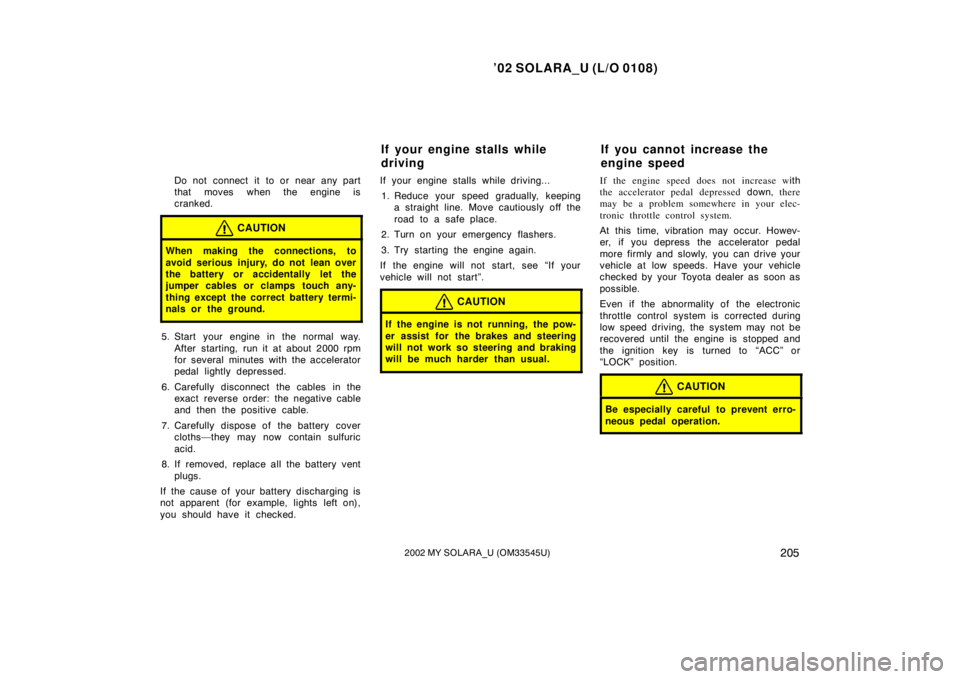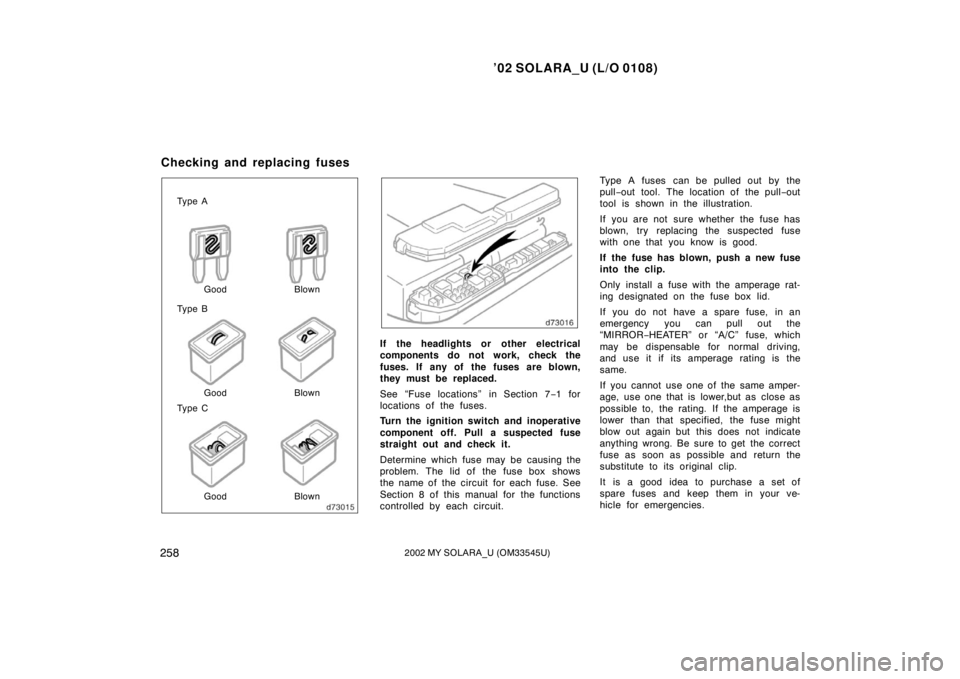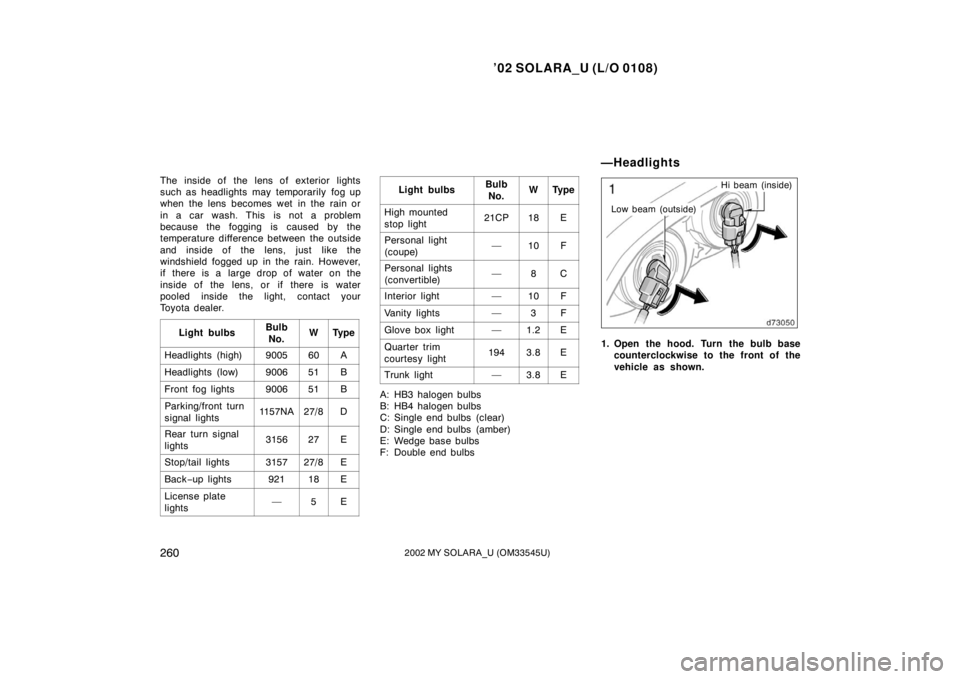Page 209 of 290

’02 SOLARA_U (L/O 0108)
2052002 MY SOLARA_U (OM33545U)
Do not connect it to or near any part
that moves when the engine is
cranked.
CAUTION
When making the connections, to
avoid serious injury, do not lean over
the battery or accidentally let the
jumper cables or clamps touch any-
thing except the correct battery termi-
nals or the ground.
5. Start your engine in the normal way.
After starting, run it at about 2000 rpm
for several minutes with the accelerator
pedal lightly depressed.
6. Carefully disconnect the cables in the exact reverse order: the negative cable
and then the positive cable.
7. Carefully dispose of the battery cover cloths—they may now contain sulfuric
acid.
8. If removed, replace all the battery vent plugs.
If the cause of your battery discharging is
not apparent (for example, lights left on),
you should have it checked. If your engine stalls while driving...
1. Reduce your speed gradually, keeping a straight line. Move cautiously off the
road to a safe place.
2. Turn on your emergency flashers.
3. Try starting the engine again.
If the engine will not start, see “If your
vehicle will not start”.
CAUTION
If the engine is not running, the pow-
er assist for the brakes and steering
will not work so steering and braking
will be much harder than usual.
If the engine speed does not increase with
the accelerator pedal depressed down, there
may be a problem somewhere in your elec-
tronic throttle control system.
At this time, vibration may occur. Howev-
er, if you depress the accelerator pedal
more firmly and slowly, you can drive your
vehicle at low speeds. Have your vehicle
checked by your Toyota dealer as soon as
possible.
Even if the abnormality of the electronic
throttle control system is corrected during
low speed driving, the system may not be
recovered until the engine is stopped and
the ignition key is turned to “ACC” or
“LOCK” position.
CAUTION
Be especially careful to prevent erro-
neous pedal operation.
If your engine stalls while
driving If you cannot incr
ease the
engine speed
Page 236 of 290

’02 SOLARA_U (L/O 0108)
2322002 MY SOLARA_U (OM33545U)
Lights
Make sure the headlights, stop lights, tail
lights, turn signal lights, and other lights
are all working. Check headlight aim.
Service reminder indicators and warning
buzzers
Check that all service reminder indicators
and warning buzzers function properly.
Steering wheel
Be alert for changes in steering condition,
such as hard steering or strange noise.
Seats
Check that all front seat controls such as
seat adjusters, seatback recliner, etc. op-
erate smoothly and that all latches lock
securely in any position. Check that the
head restraints move up and down
smoothly and that the locks hold securely
in any latched position. For folding −down
rear seatbacks, check that the latches
lock securely.
Seat belts
Check that the seat belt system such as
buckles, retractors and anchors operate
properly and smoothly. Make sure that the
belt webbings not cut, frayed, worn or
damaged. Accelerator pedal
Check the pedal for smooth operation and
uneven pedal effort or catching.
Clutch pedal
Check the pedal for smooth operation.
Brake pedal
Check the pedal for smooth operation and
that the pedal has the proper clearance.
Check the brake booster function.
Brakes
At a safe place, check that the brakes do
not pull to one side when applied.
Parking brake
Check that the lever has the proper travel
and that, on a safe incline, your vehicle
is held securely with only the parking
brake applied.
Automatic transmission “Park” mecha-
nism
Check the lock release button of the se-
lector lever for proper and smooth opera-
tion. On a safe incline, check that your
vehicle is held securely with the selector
lever in “P” position and all brakes re-
leased.
IN THE ENGINE COMPARTMENT
Items listed below should be checked
from time to time, e.g. each time when
refueling.
Washer fluid
Make sure there is sufficient fluid in the
tank. See Section 7
−3 for additional in-
formation.
Engine coolant level
Make sure the coolant level is between
the “FULL” and “LOW” lines on the see −
through reservoir when the engine is cold.
See Section 7 −2 for additional information.
Radiator, condenser, and hoses
Check that the front of the radiator and
condenser are clean and not blocked with
leaves, dirt, or insects. See Section 7 −2
for additional information.
Battery condition
Check the battery condition by the indica-
tor color. See Section 7 −3 for additional
information.
Brake fluid level
Make sure the brake fluid level is correct.
See Section 7 −2 for additional information.
Page 262 of 290

’02 SOLARA_U (L/O 0108)
2582002 MY SOLARA_U (OM33545U)
Ty p e C Ty p e A
Ty p e BGood
Good
Good Blown
Blown
Blown
If the headlights or other electrical
components do not work, check the
fuses. If any of the fuses are blown,
they must be replaced.
See “Fuse locations” in Section 7
−1 for
locations of the fuses.
Turn the ignition switch and inoperative
component off. Pull a suspected fuse
straight out and check it.
Determine which fuse may be causing the
problem. The lid of the fuse box shows
the name of the circuit for each fuse. See
Section 8 of this manual for the functions
controlled by each circuit. Type A fuses can be pulled out by the
pull
−out tool. The location of the pull −out
tool is shown in the illustration.
If you are not sure whether the fuse has
blown, try replacing the suspected fuse
with one that you know is good.
If the fuse has blown, push a new fuse
into the clip.
Only install a fuse with the amperage rat-
ing designated on the fuse box lid.
If you do not have a spare fuse, in an
emergency you can pull out the
“MIRROR− HEATER” or “A/C” fuse, which
may be dispensable for normal driving,
and use it if its amperage rating is the
same.
If you cannot use one of the same amper-
age, use one that is lower,but as close as
possible to, the rating. If the amperage is
lower than that specified, the fuse might
blow out again but this does not indicate
anything wrong. Be sure to get the correct
fuse as soon as possible and return the
substitute to its original clip.
It is a good idea to purchase a set of
spare fuses and keep them in your ve-
hicle for emergencies.
Checking and replacing fuses
Page 264 of 290

’02 SOLARA_U (L/O 0108)
2602002 MY SOLARA_U (OM33545U)
The inside of the lens of exterior lights
such as headlights may temporarily fog up
when the lens becomes wet in the rain or
in a car wash. This is not a problem
because the fogging is caused by the
temperature difference between the outside
and inside of the lens, just like the
windshield fogged up in the rain. However,
if there is a large drop of water on the
inside of the lens, or if there is water
pooled inside the light, contact your
Toyota dealer.
Light bulbs
BulbNo.WTy p e
Headlights (high)900560A
Headlights (low)900651B
Front fog lights900651B
Parking/front turn
signal lights1157NA27/8D
Rear turn signal
lights315627E
Stop/tail lights315727/8E
Back −up lights92118E
License plate
lights—5E
Light bulbsBulb
No.WTy p e
High mounted
stop light21CP18E
Personal light
(coupe)—10F
Personal lights
(convertible)—8C
Interior light—10F
Vanity lights—3F
Glove box light—1.2E
Quarter trim
courtesy light1943.8E
Trunk light—3.8E
A: HB3 halogen bulbs
B: HB4 halogen bulbs
C: Single end bulbs (clear)
D: Single end bulbs (amber)
E: Wedge base bulbs
F: Double end bulbs
Low beam (outside) Hi beam (inside)
1. Open the hood. Turn the bulb base
counterclockwise to the front of the
vehicle as shown.
—Headlights
Page 265 of 290
’02 SOLARA_U (L/O 0108)
2612002 MY SOLARA_U (OM33545U)
2. Unplug the connector while depress-
ing the lock release.
If the connector is tight, wiggle it.3. Install a new bulb and connector into the mounting hole.
Aiming is not necessary after replacing
the bulb. When aiming adjustment is nec-
essary, contact your Toyota dealer.1. Remove the bolts, take out the en- gine under cover.
—Front fog lights
Page 267 of 290
’02 SOLARA_U (L/O 0108)
2632002 MY SOLARA_U (OM33545U)
Use a Phillips�head screwdriver.
Type A Type B
Use a phillips�head screw driver. Remove
and install the cover clips as shown in
the following illustrations.
—Parking/front turn signal
lights —Rear turn signal, stop/tail,
and back�up lights
Page 269 of 290
’02 SOLARA_U (L/O 0108)
2652002 MY SOLARA_U (OM33545U)
a: Rear turn signal light
b: Stop/tail light
c: Back�up light
—License plate lights
( lef t sid e)
Page 270 of 290
’02 SOLARA_U (L/O 0108)
2662002 MY SOLARA_U (OM33545U)
—License plate lights
(right side) —High mounted stoplight